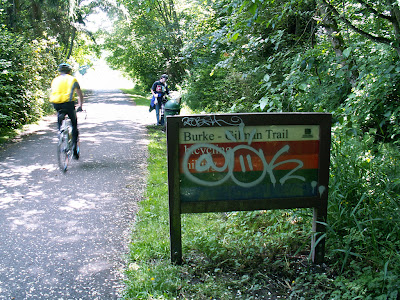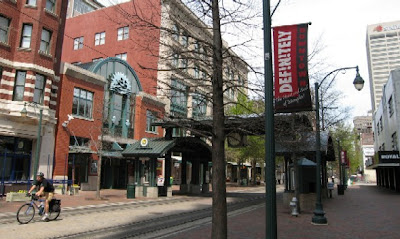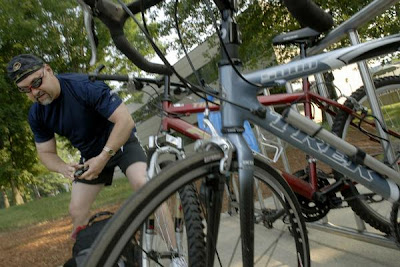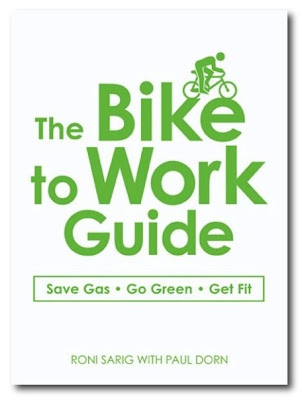 Maggie Robbins has been a recreational cyclist for many years, but only started biking around town after moving to San Francisco in 1994. She became a multimodal bike commuter-- combining biking and BART--a year later when her office moved from central San Francisco to Oakland. Robbins joined the San Francisco Bicycle Coalition board of directors in 1997 and remained for six years, eventually serving as treasurer and president, and helping with the organization's first strategic planning process. During Robbin's tenure on the board, the SFBC entered serious electoral politics for the first time, endorsing and actively supporting pro-bike candidates for Mayor and Board of Supervisors. She was also there when the SFBC helped launch a companion organization, Transportation for a Livable City (now called Livable City). Robbins graciously served briefly on the board of the California Bicycle Coalition, after I recruited her during my brief tenure as the organization's executive director.
Maggie Robbins has been a recreational cyclist for many years, but only started biking around town after moving to San Francisco in 1994. She became a multimodal bike commuter-- combining biking and BART--a year later when her office moved from central San Francisco to Oakland. Robbins joined the San Francisco Bicycle Coalition board of directors in 1997 and remained for six years, eventually serving as treasurer and president, and helping with the organization's first strategic planning process. During Robbin's tenure on the board, the SFBC entered serious electoral politics for the first time, endorsing and actively supporting pro-bike candidates for Mayor and Board of Supervisors. She was also there when the SFBC helped launch a companion organization, Transportation for a Livable City (now called Livable City). Robbins graciously served briefly on the board of the California Bicycle Coalition, after I recruited her during my brief tenure as the organization's executive director.
As part of Bike Commute Tips' commemoration of the 10th anniversary of the pivotal 1997 confrontation between Critical Mass and San Francisco Mayor Willie Brown, I recently asked Robbins for her impressions of how San Francisco has changed for bicyclists in the past decade.
Bike Commute Tips: What is the biggest positive change you've observed for bicycling in San Francisco in the past 10 years?
Maggie Robbins: The greater number of bicyclists is the most striking change to me. This is due both to more and better bike infrastructure, but also to better promotion and encouragement of bicycling by the SFBC, the City, and more broadly through events like Bike to Work Day. There is an increasingly diverse and eclectic bike culture in the city, which I think has enough different facets that just about anyone can feel like they belong. And I think that some interest in biking now is due to both the continuing problems with MUNI bus and subway service, and more people realizing their personal choices about transportation are important in terms of global warming, the environment generally, and even in terms of US foreign policy such as the Iraq War.
The increase in bicycling infrastructure is the next most prominent change. It’s been really impressive in the past decade. The increase in infrastructure, particularly the bike lanes, was clearly due to advocacy. These changes would not have happened with outclear, consistent advocacy. And by advocacy I don’t mean politely asking the Department of Parking and Traffic to consider adding a few more bike lanes, where there’s a little room left over on the road, please. I mean pushing City leaders to get serious about making room for bikes on the road, and yes even when there is no “extra” room for it.
We do the quiet stuff: reasoned lobbying, writing letters to officials, writing practical proposals and giving concrete analyses of DPT proposals. But we also pack hearings with supporters and hold protest rallies and do publicity stunts and make noise, and we are demanding and “unreasonable” (aren’t most of our demands seen as "unreasonable?") And we hit candidates where it counts: by working to get them elected or defeated based on their bicycling politics. And, we embrace, if occasionally a bit uncomfortably, one of the most creative forces to come to biking in a very long time: Critical Mass.
Bike Commute Tips: Among other things, the on-street infrastructural enhancements you mentioned (bike lanes, sharrows, etc.) are critical for a more bicycling-friendly community. Some bicyclists in the U.S. dispute this, thinking that cyclists should simply learn--through "street skills" education--to take their rightful place in traffic. What is your view of the importance of street design ("complete streets") for encouraging a better bicycling environment?
Robbins: Let’s be clear, bicycles are not cars. In places where the size, speed, and number of cars and trucks literally push bikes off the road, we need designated space on the roadway just for bikes. This protects cyclists from being injured or killed, and allows them to use busier roadways without it being a struggle every day. In areas where there are few cars, driving slowly, bikes and cars sharing the same lane is OK--and traffic calming can help this really work.
The SFBC context is a city, with a dense downtown on one edge, some freeways and busy arterial streets, some light industry areas, some quiet residential streets, some bustling neighborhood shopping streets, and lots of variation, depending on the specific part of town you’re in. We need different solutions for different kinds of streets. In some areas, the only way to make biking safe, efficient, and comfortable for most people it to have separate bike lanes, either striped, or with a barrier separating from heavy traffic. We need these lanes to be there along the whole road, including through the tight spots and especially through the dicey intersections. Many people are reluctant to ride due to fear of traffic, and one way to reduce that fear is to give bikes their own space, including signs, pavement marks, signals, and so on to show them the way. Most parents, for example, will be reluctant to let their children bicycle to school in the city unless they are certain their children, even older children, are not competing with cars for space on the road.
We don’t require pedestrians to share the road with cars, do we? Not usually. We see how great the difference is between our slow soft body and a motor vehicle and know we should separate them. For a very long time, we have created safe areas for walkers called sidewalks. Sidewalks are a good idea. So are bike lanes and paths.
Bike Commute Tips: Beyond bike lanes, what are the key social/cultural/political factors that have improved bicycling in San Francisco?
Robbins: Advocacy for bike lanes is politics. Any bike coalition that thinks they don’t have to do politics is fooling themselves. One thing we don’t often talk about is how to get elected officials to get serious about biking. Aside from information, persuasion and agitation, there is electoral politics: that is, getting pro-bike candidates elected so they can turn city policy and budget to support more bicycling.
Not a single bike lane is striped in this city until the Board of Supervisors votes on it. And the city’s administration won’t put the staff and resources into bike infrastructure if the Mayor doesn’t want them to. Without these decision-makers on board, bikes will continue being marginalized in policy, funding, and infrastructure. Responding to this reality, the SFBC board asked the members if they would agree to change our non-profit status to allow the SFBC to engage in electoral politics. They agreed overwhelmingly. San Francisco is not that big a place, maybe 600,000 residents spread over 49 square miles of land. There are 11 city electoral districts. An organization with an activist, political membership such as ours can make a difference, and our members saw that.
In keeping with the SFBC’s tradition of member control, we put in place a member-centered endorsement process. It begins with a survey of all the candidates. The results are compiled by a volunteer committee (composed of board, staff and members from each electoral district) who also summarize past experience the SFBC has with the candidate regarding bike issues. Every member is sent this information and they vote on whom the SFBC should endorse for their district. The board makes the final decision based on the member vote.
The candidates don’t always agree with what the SFBC demands, but now most serious candidates for local office are able to talk about our issues, however superficially. And we ask candidates to support specific bike-related proposals. Once they are elected, we can then work to hold them to these promises. This didn’t happen before. In a way, being active in elections is the ultimate education program for our local elected officials. They have to learn at least a little about our issues because our 6,000-plus members vote, and we influence many other votes. We have a long way to go in expanding the vision of our politicians and the public on what the future could look like, but elections has moved this a step forward.
I realize not all bike coalitions feel they can do this because they rely on--or wish they could rely on--grants and donations that depend on their charitable status, being a 501(c)(3). But I think the more activist bike coalitions should think seriously about whether or not they want to be a 501(c)(3) charity, or a 501(c)(4) like the SFBC, that is still a nonprofit but is not tax exempt and can engage in much more political activity than a 501(c)(3). Frankly, even when the SFBC was a 501(c)(3) it was very difficult for us to get charitable grants. We were perceived as being a political organization, regardless of our being very careful about staying within the legal limits on lobbying by charities. Bicycling just was not something most local foundations were willing to give grants for, no matter how we pitched it. In the end, we didn’t think the potential loss of funding would be that great. And at the same time, we created a sister “SFBC Education Fund” that can accept grants and donations for bike education work, which is a 501(c)(3) tax-exempt charity.
Bike Commute Tips: Many cities around the world--including Paris, London, Bogata, New York, Portland--have made major strides in creating a more welcoming street environment for pedestrians and bicyclists. Often these improvements have come because of visionary leadership by city government. In San Francisco we have usually made progress in spite of, not because of political leadership. What will it take to finally change the political climate in San Francisco to better favor alternative transportation? What has been missing at City Hall?
Robbins: I think most bike advocates don’t think seriously enough about what it would take to get the bicycling share of trips in SF (or wherever) up to say 20 percent. How do we have to reallocate space between bikes and vehicles, to make 10 or 20 percent of the public comfortable riding to get around? How do we clear the roads so transit will work well for those times a bike won’t do, so a car isn’t the only other option? Lets look at Amsterdam, where if you bicycle around town you almost never have to share the lane with a car. You have separated bike lanes, or striped lanes, with separate traffic lights, signs and pavement marking, and often separate routing off the roadway to get you through tricky areas. Unlike here, where when the going gets tight the bike lane just ends and dumps you into the traffic lane to navigate a tricky intersection on your own. And in Amsterdam the light rail system has its own dedicated space in much of the city, so trains aren’t stuck in traffic.
Also, what changes need to happen off the street to make 20 percent bike rideshare possible? For example, where would all those bikes be parked? How would all those thousands of bicyclist lock their bike at any of our BART stations, at their work, in their shopping district, or at their school? Adding a few hundred more U-racks on the sidewalks each year as we do now won’t do it. We will have to re-divide the space to accommodate more people riding bikes in a way that doesn’t compete with pedestrians. We need to make sure new infrastructure has this future in mind, not wring our hands later saying we don’t have space for more bike parking. For example, at the new Transbay Terminal multi-modal transit hub that has been in planning for several years. Will it have space for thousands of bicycles to arrive and park each day? Right now no one seems to take this 20 percent scenario seriously, so they will design and build a new terminal with bikes a small consideration, relegated to the fringes, a bike lane will lead up to it, maybe with a small bike-station for parking a few dozen bikes. Nothing radically new. And in a few years, when those thousands of new bicyclists ponder riding to the terminal, many of them will decide not to.
I spent the last year in London. While there are significant differences in the infrastructure between our cities, it was a joy to ride there. London has made serious investment to increase bicycling, walking and transit. They have the same problems we have: dense city, limited roadway space, many demands on the city budget. But the Mayor had the will, and he came up with a way to raise the money, and got the people of London to agree. They charge a substantial fee to drive into Central London (the congestion charge) during the week days and Saturday, and they pump that huge amount of money into expanding transit and improving bike and ped infrastructure. That was the deal: in exchange for making driving downtown more costly, you’ll get better transit, biking, and walking around in return. They have put thousands more busses on the road. They upgraded the bus fleet with better-designed busses (including clean diesel engines). There’s been a massive traffic calming program throughout the city, lots of bike paths and lanes added, and sidewalks and pedestrian plazas have been expanded.
We could do this, but our leaders, frankly even the bike advocates, don’t think quite this big. Maybe it’s a lack of confidence, or lack of trust in officials to not redirect the money to other things, or that the voters would rebel. I don’t know.
Bike Commute Tips: What are the remaining challenges in San Francisco you would most like to see improved in the next decade? Based on your experience as a bicyclist and advocate, how optimistic are you that these challenges will be resolved?
Robbins: Americans seem to think that foreign cities who are doing things right in terms of transit or biking had some sort of natural advantage over the US. But it isn’t true. They were on the “every adult drives a car everywhere” track, just as the US is. They were tearing up light rail and reducing bus and train service. The difference is that they saw the writing on the wall about that being the road to oblivion bit sooner than we have--the US hasn’t seen the writing yet. And in response the governments of these cities have taken bolder action than we have. The results we see in these cities are due to hard work, and to leaders and bike and transit advocates who think seriously about the future. We won’t accidentally drift into a better future, we must build it one change at a time. Today it’s a few bike lanes, next it will be colored paving, then maybe bike traffic signals or getting rid of the LOS standard for streets, and some day, if we demand it hard enough, if we entice thousands of more people onto bicycles each day, we’ll get to a truly bike-friendly city.
Am I optimistic? Yes. What alternative is there?
Additional Bike Commuting Tips 10th Anniversary Interviews:Josh Switzky: Cycling planner
John Holtzclaw: Cycling Environmentalist
Dave Snyder: Visionary Velorutionary
Anna Sojourner: The city on two wheels
Image: Courtesy Maggie Robbins.
Visit: Paul Dorn's Bike Commuting Tips Site
 From the Honolulu Advertiser, 07.30.07:
From the Honolulu Advertiser, 07.30.07: 











